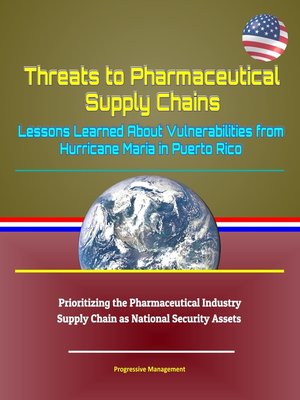Threats to Pharmaceutical Supply Chains
ebook ∣ Lessons Learned About Vulnerabilities from Hurricane Maria in Puerto Rico, Prioritizing the Pharmaceutical Industry Supply Chain as National Security Assets

Sign up to save your library
With an OverDrive account, you can save your favorite libraries for at-a-glance information about availability. Find out more about OverDrive accounts.
Find this title in Libby, the library reading app by OverDrive.



Search for a digital library with this title
Title found at these libraries:
| Library Name | Distance |
|---|---|
| Loading... |
This important report from 2018 has been professionally converted for accurate flowing-text e-book format reproduction. In September 2017, Hurricane Maria caused severe devastation to the U.S. territory of Puerto Rico, which manufacturers nearly 10 percent of all drugs consumed by Americans. Given the large concentration of pharmaceutical manufacturing based in Puerto Rico, the destruction wrought by a Category 4 hurricane created shortages for specific medical products, which affected the standard of health care in the United States during an influenza epidemic throughout late 2017 and early 2018. The Analytic Exchange Program's (AEP's) team examining "Threats to Pharmaceutical Supply Chains" examines this event as a case study for the risks and implications of pharmaceutical supply chain disruption. What happened after Hurricane Maria could shed light on other supply chain vulnerabilities, including the effect of cyber-attacks against manufacturing infrastructure, geopolitical disputes affecting drug supply chain components, and the growing reliance on third party drug manufacturing and logistics suppliers. Awareness of vulnerabilities is the first step toward protecting the pharmaceutical supply chain as a component of critical infrastructure vital to U.S. national security interests. Our team recommends mitigating future supply chain disruption by increasing private sector and government coordination. This AEP team proposes several specific solutions policymakers and corporate executives should consider, including providing incentives for greater cooperation, prioritizing the U.S. pharmaceutical industry as a unique critical infrastructure component and national security asset, creating an industry-wide list of medications deemed "critical", and streamlining the approval process for backup medications and alternative sources of temporary production.
This compilation includes a reproduction of the 2019 Worldwide Threat Assessment of the U.S. Intelligence Community.
Executive Summary * Hurricane Maria and the Impact on the US Pharmaceutical Supply Chain: A Case Study * How Hurricane Maria Affected Pharmaceutical Manufacturing in Puerto Rico * Bad to Worse: Hurricane Maria and the US Flu Outbreak * Explaining Why Hurricane Maria Had Such an Impact * Beyond Our Case Study: Examining Risks and Hypothetical Scenarios * How Did We Get Here? Examining the Risks * Risk-based Hypothetical Scenarios * Observations and Recommendations * Goal: Expedite and Reinforce Manufacturer Disclosure of Drug Shortages to the FDA * Goal: Prioritize Disruptions to the Supply Chain or Manufacturing of Critical Drugs * Goal: Improving Incentives for Manufacturers to Maintain Supply * Goal: Prioritizing the Pharmaceutical Industry Supply Chain as National Security Assets * Concluding Remarks * Citations







